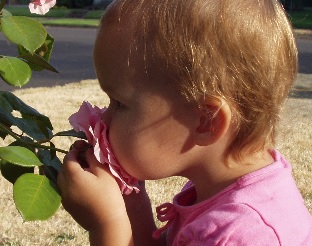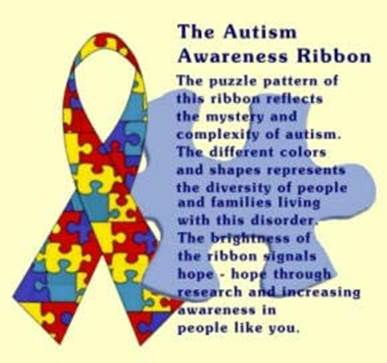
This page contains content from an e-mail sent to members of the www.BehaviorAdvisor.com "B-list" on 4/13/13.
To receive informational mailings such as this one, sign up!
.
.
.Subject heading of e-mail: Autistic students in our classroom
Yes, I know that I’m supposed to put the child before the condition (“Students with autism” instead of my subject heading; “Autistic students”) However, I trust that all of us here today always see the youngster through the disability. We agree with William Shakespeare that “A rose by any other name would smell as sweet.” or in more vernacular terms, "It’s 6 of one, and a half dozen of the other". 
It is important though, to use the “child first” phraseology with non-aware folks so that they come to see what we see: A real-life child with his/her own personality, life-space, and interests…along with having the challenge of a disability. Just to error on the side of caution then, let me rearrange the words in the subject heading of this e-mail as we talk for the next few weeks about kids with autism.
Oh wait!! We can only talk about Autism for the rest of this April! In May (2013), that term will cease to exist. It will metamorphise (Is that a word? If not, I'm laying claim to it: Copyright McIntyre 2013) into “Autistic Spectrum Disorder” (in the new version of the Diagnostic and Statistical Manual of the American Psychiatric Association - DSM-5).
 Let's back up the bus. Of all the mental health disorders that we could talk about this week (April 15th), why talk about Autism? For many of you, a brain bulb just switched on and you're saying “Of course!”, knowing that it is Autism Awareness Month. Yes! In order to highlight the growing need for awareness and action regarding individuals on the autistic spectrum, the Autism Society has been promoting Autism Awareness Month since the 1970s. They, along with many of us, recognize April as a chance to educate professionals and the public at large about the condition and essential issues impacting the autism community.
Let's back up the bus. Of all the mental health disorders that we could talk about this week (April 15th), why talk about Autism? For many of you, a brain bulb just switched on and you're saying “Of course!”, knowing that it is Autism Awareness Month. Yes! In order to highlight the growing need for awareness and action regarding individuals on the autistic spectrum, the Autism Society has been promoting Autism Awareness Month since the 1970s. They, along with many of us, recognize April as a chance to educate professionals and the public at large about the condition and essential issues impacting the autism community.
Already aware? SUPER DUPER! …But at which level? As educators, parents, child advocates, and those who serve youngsters in other capacities, we need to constantly be boosting our level of awareness (and skills, knowledge, and wisdom). Yes, we’re all aware, but: Would you recognize indicators of autism in the young child of a friend? Do you know how to include the youngster academically and socially into your classroom or group? Are you cognizant of the issues that impact the lives of families of children with autism?
Here’s what’s in store if you continue on with your reading today: 1. A quick review of some important information related to kids with autism (Level of awareness: Basic) 2. My offering of another opinion that borders on being politically incorrect like the 'child-first' versus 'label-first' thought that opened this e-mail (Level of awareness: Basic+) 3. The link to our video of the week in which we follow "Sally P.", a 10-year old on the spectrum (Level of awareness: Basic, Advanced, Assessment, Empathy, Knowledge base, Skill acquisition) 4. A link to a page that I wrote with one of my grad students regarding effective teaching of kids with autism (Level of awareness: Overview and strategies) And… 5. An absolutely wonderful cornucopia of music (you’ll be able to listen to a great deal of it for FREE) that is not only beautifully composed, arranged, played and sung, but also teaches social skills and cognitive processing of events and feelings to youngsters with autism (and other mental health and behavioral issues).
I was floored when I first listened to this CD. 
It is nourishment to the ear, the soul, and the cerebral cortex. (Level of awareness: Instruction & intervention)
But it's work first, then music break, so let's get started...
How many youngsters have Autism?
The number of youngsters with autism around the world continues to increase. According to the Centers for Disease Control and Prevention (CDC) in the U.S. (March-April, 2013), it is estimated that 1 in 88 American children has some variation or degree of autism. That is an increase of nearly 80% compared to just a decade earlier.
How was this finding determined? Since 2000, the CDC’s Autism and Developmental Disabilities Monitoring Network has based its estimates on a bi-annual counting of how many 8-year-olds in about a dozen communities across the nation have autism. (The number of sites has ranged from 6 to 14 over the years, depending on the availability of funding in a particular year.)
In 2000 and 2002, the autism estimate was about 1 in 150 children. Two years later 1 in 125 of the 8-year-olds had autism. In 2006, the number was 1 in 110, and in 2008 -- 1 in 88 children had the condition.

Boys with autism continue to outnumber girls 5-to-1, according to the CDC report. It estimates that 1 in 54 boys in the United States have autism to some degree.
Note: As of May 2013, Aspergers syndrome will no longer be recognized as a condition separate from autism. The youngsters who have the symptoms of this now defunct condition will be labeled as having autism. See the page on Aspergers syndrome for more information. (a link will be placed here in a couple of weeks)
What are the signs & symptoms of Autism?
In general, kids with autism have a neurodevelopment disorder (brain neurology-biology complications) that leads to impaired language abilities, difficulties in inter-personal communication, and under-developed social skills. The video will answer this question in more depth.
Intervention and strategies
Well-conducted research studies show that the earlier the implementation of effective the interventions, the better the long-term outcomes for kids on the autistic spectrum. Of course, early intervention is dependent on early identification of the disorder. The video (below) discusses some of those approaches.
Professional envy on the part of Dr. Mac
During autism awareness month, it is difficult to imagine an educational professional being unaware of the condition. Some of us may need more knowledge and skills to better empathize with and serve these youngsters, but all-in-all, massive strides have been made in educating school-based personnel, and the public at large. The support movement for these youngsters is well-funded and well-coordinated.
While I’ve served kids with all sorts of disabilities/challenges, my life’s work as a special educator has been primarily with kids who have conduct disorders. These are the youngsters who engage in persistant and resistant deceitfulness, defiance, aggression,theft, destruction of property, and breaking of societal rules. I must admit to being envious of the attention and societal concern that the autism advocacy groups have garnered through their extensive efforts: Insurance coverage for treatment, research dollars that support a rapidly increasing understanding of the condition, required training for all teachers in many geographic areas around the globe, and more… All for a population of youngsters that comprises about 1 in every 88 kids.
Please don’t read my commentary as being resentful. As I said, I am envious. I hold great admiration for these advocacy groups who are to be praised for the attention they have focused onto the needs and welfare of their kids. My question is: “How do we garner this same level of concern and support for social/emotional/behavioral conditions that are found at even higher levels in our school-aged population?"
Take for examples, conduct disorders that are present in 1 in 6 youths, and ADHD that affects 1 in 11 kids. The general public has little empathy or tolerance for these youngsters, and even many who are charged with the task of serving them well in educational and/or recreational programs, blame the victims for their conditions. Blame the victim? Kids with conduct disorders who victimize others are victims themselves? Consider this: When these youngsters were in the womb, were they thinking to themselves “When I get out there, I’m going to wreak havoc!” When they popped out onto our blue-green orb, do you think that as neo-nates they thought to themselves: “Let the mischief begin.”
Kids are a result of, products of, and unfortunately, sometimes victims of the circumstances in which they have been placed. When they “turn out bad”, drowning in a sea of illicit or illegal behavior, it is our job to rescue them, not throw them a rock.
So many conditions have an awareness month or week…or at least a day, so I’m suggesting an observance for kids with conduct disorders: "Conduct disorder night". I know that "conduct disorder day" rolls off the tongue a whole lot easier, but a quick check of my calendar shows that every day of the year holds recognition of some event, condition, person, place or thing. And consider that one of the diagnostic criteria for conduct disorder is “…often stays out at night despite parental prohibitions.” So which night do you suggest, given that some have already been taken?
OH YEAH... this is the page on Autism Spectrum Disorders. Back to topic...
Here's the link to a 2- Part video made by one of the many excellent graduate students in my program to train teachers of students with emotional and/or behavioral disorders. (Thanks, Lindsey!) In the video, we'll see an overview of the Autistic Spectrum, causation theories, diagnostic criteria, therapies/interventions (direct teaching, social stories, direct signals to change sensory channels, visual supprts, OT, Sensory integration, environmental modifications) as they apply to "Sally", a 10 year old girl with (as it is known in April 2013) Autism. Part 1 .... Part 2
Here's the link to a page regarding autism that I co-authored with one of my former grad students.
_____
OK! You've earned your music break. Enjoy this wonderful offering...
HOLY COW! 
Those were the words that emanated from my mouth when I first heard what you can now sample for free. Let me leave the levity here and describe what occurred.
I receive an e-mail from one of our B-list community. "Niki" offers some compliments regarding BehaviorAdvisor.com, and then asks whether I might review her CD of music. I always respond to B-listers and BehaviorAdvisor visitors, but I'm considering saying "Thanks, but no." to her. I'm just so overloaded with work, when would I find the time? I'm not sure why I said "Yes. Send it along, Niki.", but I did so.
A package arrives with 3 CDs. While riding the train from home to NYC, I insert the disk into my laptop and prepare to hear some rather amateurish, cutesy background music through my ear buds while I score student papers. The music begins, and I raise my eyes from the paper, tilt my head, and utter those words next to the image of the perforated bovine above. The surprised rider next to me might tell you that I used a word other than 'cow', but I categorically deny that accusation.
I was captivated by the songs. Not only were they capsulated in a beautiful voice and stellar guitar playing, the lyrics were the words that a kid struggling to be self-regulated in a perplexing situation would think as s/he remembers the steps to follow in reacting appropriately to the circumstances in which s/he finds him/herself!
Upon arriving at my office, I e-mailed Niki with accolades and requests for more information. Niki is a teacher and a mother of a child on the Autistic Spectrum. She is deeply aware of issues and practices regarding kids with this condition. As a musician, she has composed, arranged and played songs that kids can remember so that they are better able to manage emotions, engage in appropriate actions, and display social skills. These were not the usual chants that teachers of kids with ASD/Pervasive Developmental Disorders often play for the kids. This was high-quality material swaddled in lovely sounds.

I invite you to take a listen to excerpts from Niki's songs. Here's the url: www.nikischomasmusic.com
If you agree with me that these tunes would be of great benefit to your kids, return to this page and click on the CD cover image (below) to purchase it. Otherwise, enjoy the music.
From the U.S.? Click on this Left Side CD cover .............. From outside the States? Click on this right-side CD cover
Below, You'll find Niki's Bio, the Basic Objectives of each song, AND Objectives for your use in educational and/or clinical settings.
Niki's Biography:
Niki Schomas began writing music that adults and children would enjoy listening to while she was in college. The benefits for children became evident immediately in her own classroom shortly after her graduation. Now, drawing on her years of experience as a musician, her 15 years as a special educator, and her skills learned from being a parent of two energieic young boys, she set out to find a new way of incorporating music into her curriculum.
With her son’s diagnosis of autism driving her passion, she also realized the urgency of properly teaching not only mainstream children, but those in her classroom, using her guitar and her voice. After researching preexisting programs, and drawing on children’s natural love for music, Niki realized the huge lack of quality in the area of social skills instruction.
The result is a 27-song album entitled “Beautiful You” released in December 2012. Drawing on concepts such as learning new coping strategies, teaching children to navigate social situations, and having them understand the natural ambiguities of life, Niki’s music is being used by parents and educators alike. Niki wrote and produced the album to be utilized in the classroom by general and special education teachers and for families at home. Her purpose allows teaching of social concepts through music to be is inspirational, effective, and most of all fun.
Song Title |
Global Objectives |
Accidents Happen |
To learn how to react appropriately when “accidents happen” |
All I Can Do |
To recognize the importance of doing and being your best. |
Back and Forth |
To identify the basic components of reciprocal communication. |
Beautiful You |
To articulate the positive qualities that every individual has that makes them beautiful. |
Breathe |
To learn how to breathe as a way to cope with stress or anger. |
Breathe Through the Change |
To identify how change change can be difficult, and how to learn to appropriately cope with changes in routine. |
Choose |
To recognize and feel empowered in the ability to make good choices. |
Confidence |
To define what it means to have confidence. |
Different People |
To recognize that different people need different things to be successful in life. |
Empathy |
To define the term empathy, and illustrate various ways of demonstrating empathy with others. |
I Am Assertive |
To define what it means to be assertive. |
I Can Wait |
To recognize the importance of patiently waiting. |
I Get Angry |
To identify various things that trigger anger, and appropriate ways to cope with anger. |
Let My Worries Fly Away |
To use the visualization strategy of pretending your worries are flying away as a coping mechanism. |
Listen |
To define what it means to listen. |
Look ‘Em in the Eye |
To articulate various social communication behaviors, and the importance of eye contact |
Make a Plan |
To problem solve how to make a plan to successfully manage tasks. |
Other People’s Words |
To learn how to cope with the words that other people say. |
Pay Attention |
To recognize the importance of paying attention. |
Picture a Happy Place |
To use the visualization strategy of picturing a happy place during stressful situations. |
Power in Change |
To identify the importance of changes in routine, and how to successfully navigate change. |
Power to Change the World |
Students will recognize that they have the ability to change things in their world. |
Recognize the Signs |
To recognize the physiological signs that are associated with stress. |
Safe Place |
Students will learn how to visualize a “safe place” as a coping mechanism when dealing with stress and/or anxiety. |
Self-Talk |
Students will learn how to positively talk themselves through various situations. |
Stand Up |
To recognize the importance of standing up for yourself and others in an appropriate way. |
Version of Me |
Students will recognize the importance of being the best “version” of themselves, and describe how this is defined by making good choices and doing their best. |
Song Title |
Global Objectives - Educational and/or Clinical Settings |
Accidents Happen |
Students will demonstrate the ability to identify what an “accident” is, and demonstrate ability to respond appropriately toward others when accidents occur. |
All I Can Do |
Students will analyze and define how to demonstrate their “personal best”, how to respond to “disappointment and/or making mistakes”, and positively cope with natural outcomes. |
Back and Forth |
Students will analyze and demonstrate the various components of effective communication. |
Beautiful You |
Students will analyze different ways to positively communicate about themselves and others, and will generate individual lists of positive attributes that describe themselves individually as well as others. |
Breathe |
Students will identify various triggers that cause them stress, identify and describe a healthy coping strategy, and implement the strategy when applicable. |
Breathe Through the Change |
Students will identify and describe how changes or transitions in their routine can lead to stress, and explain how positive self-talk will help them successfully transition throughout their day(s). |
Choose |
Students will recognize and feel empowered at the realization that they have the power to choose, and that there are more positive results when good choices are made. |
Confidence |
Students will define the term “confidence”, evaluate various examples of what it means to have or not demonstrate having confidence, and will generate and demonstrate a list of “confident behaviors. |
Different People |
Students will recognize the differences between individual supports that people need for different reasons. |
Empathy |
Students will define and illustrate what “empathy” means and demonstrate how to be empathetic to others. |
I Am Assertive |
Students will define the concept of “assertiveness”, and provide examples how to appropriately “assert” themselves in various situations. |
I Can Wait |
Students will understand the importance of waiting, identify various reasons why it is difficult to wait, and comprehend and demonstrate the importance of waiting. |
I Get Angry |
Students will identify what triggers their anger and how to appropriately cope with their anger. |
Let My Worries Fly Away |
Students will identify the triggers that might cause worrying, and visualize their worries “flying away” as they learn to successfully learn to cope with their worries. |
Listen |
Students will identify the importance of listening and illustrate what “listening” looks like in terms of appropriate behavior. |
Look ‘Em in the Eye |
Students will identify and describe the various aspects of successful communication that involve eye contact, proximity, and turn taking. |
Make a Plan |
Students will understand how to “make a plan” in terms of the steps they need to take in order to accomplish and problem-solve by breaking down things into smaller steps. |
Other People’s Words |
Students will identify how other people’s words can affect them and will recognize how to cope with how they feel in response. |
Pay Attention |
Students will recognize the importance of paying attention and identify the various behaviors that are evident when they are “paying attention”. |
Picture a Happy Place |
Students will visualize a place that makes them happy as a means to learning a new coping skill when stressed or upset. |
Power in Change |
Students will recognize their own struggle with change in response to their feelings of a loss of control, and will be empowered to learn that the control they desire to have is within them as they learn that they have “power” in dealing with change. |
Power to Change the World |
Students will recognize that they have the ability to change things in their world. |
Recognize the Signs |
Students will identify various things that might trigger their anxiety; how to recognize the signs of how anxiety affects them, and identify various healthy ways they can help themselves in these situations. |
Safe Place |
Students will learn how to visualize a “safe place” as a coping mechanism when dealing with stress and/or anxiety. |
Self-Talk |
Students will learn how to positively talk themselves through various situations. |
Stand Up |
Students will identify and define what it means to “stand up” for what they believe in terms of appropriately advocating for themselves and others. |
Version of Me |
Students will recognize the importance of being the best “version” of themselves, and describe how this is defined by making good choices and doing their best. |
 Hmm... ritualistic and repetitive behavior... Let's sing Niki's song together.
Hmm... ritualistic and repetitive behavior... Let's sing Niki's song together.
.
.
Author: Tom McIntyre - DoctorMac@BehaviorAdvisor.com
.
.
.
